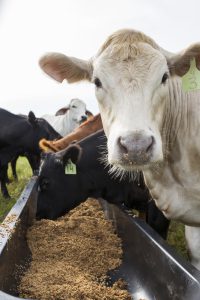Projected freezing temperatures over the weekend are a reminder of the impact weather has on cattle management. With freezing temperatures, frost is inevitable, meaning nutritive value of forage is going to be reduced. Adjustments to how cattle are managed to meet nutrient requirements will need to be addressed as a result.
WINTER SUPPLEMENTATION
Supplementation is the addition of something to make up for a deficiency. Inadequate nutritive value of available forage cause cattle to have a deficiency of needed nutrients. As nutritive value of forage declines winter supplementation of cattle provides the extra nutrients they need. Winter supplementation should start early, either when calving begins, if on a fall calving schedule, or after the first frost. Starting supplementation before cattle start losing body weight will help maintain the condition of cattle. Supplementation should be appropriate to support a cow Body Condition Score (BCS) of 5 – 6. (How to Measure Body Condition Score in Florida Beef Cattle AN347-12236259.pdf (ufl.edu))
DETERMINING NUTRIENT REQUIREMENTS FOR CATTLE
Body weight and milk production are used to determine the nutrient requirements for cattle. Actual body weight or an estimate of body weight can be used. Milk production can be estimated by using the Peak Milk Calculator tool. (Calculators – University of Florida, Institute of Food and Agricultural Sciences (ufl.edu)). Basic Nutrient Requirements of Beef Cattle (AN19000.pdf (ufl.edu)) is a guide for the amount of energy and protein needed.
NUTRITIVE VALUE OF FORAGE
The next step in developing a winter supplementation program will be knowing the nutritive value of forage. A lab analysis of forage will provide nutritional information needed for the development of a winter supplementation program. The nutrients that are available or lacking in forage impact the amount and type of supplemental feed needed.

SUPPLEMENTAL FEED
Nutrient requirements of cattle and available nutrition through forage will determine the amount and type of supplemental feed needed. Cattle feed is classified based on content and to a certain degree TDN (Total Digestible Nutrients) value. Knowing whether cattle are deficient in energy, protein or both will influence supplemental feed type used. Supplemental feed provides the nutrients that are not available through forage.
Having a winter supplementation program will help cattle maintain a desirable BCS and meet their nutrient requirements. Utilize cow body weights and milk production estimates to determine the nutrient requirements of cattle. Analyze the nutritive value of forage before making supplemental feed decisions. Once available nutrients through forage have been analyzed and nutrient requirements of cattle determined use supplementation to correct nutritional deficiency.
For additional information on winter supplementation of beef cattle contact your local UF/IFAS County Extension Agent.
Sources:
Banner Cover Photo Credit: UF/IFAS Photo by Tyler Jones
 8
8
